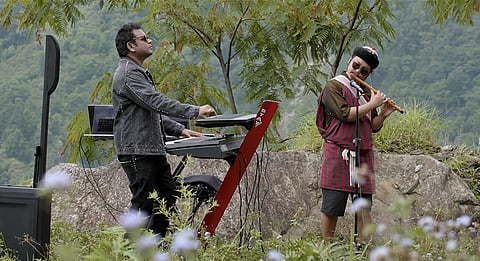
- Reviews
- Power List 2024
- Cannes 2024
- In-Depth Stories
- Web Stories
- News
- FC Lists
- Interviews
- Features
- FC SpecialsFC Specials

In Harmony with AR Rahman, when the composer jams with Ustad Mohi Baha'uddin Dagar, he on his continuum fingerboard, him with his Rudra Veena, and Rahman tells Baha'uddin that he can't play classical at his level, and Baha'uddin tells Rahman that he can't play as fast as him, it isn't modesty. There is a moment of genuine musical gulf. But even when their styles are poles apart, two musicians will find a way to communicate. "When I'm playing slow, I'm thinking of you," Rahman offers a solution. They take it from there.
When it was learnt that Rahman is doing a show for Amazon, which would see him travel across the country to meet practitioners of disappearing musical traditions, the first curiosity was how the composer would fare in such a format, considering how awkward and shy he is in front of the camera. But there is something that artists are able to bring out within artists when they interact that interviews cannot. Harmony with AR Rahman tells us as much about the Academy and Grammy award-winning composer who in his 26-year-old career has expressed a lot more through his music than he has through his words, as about these rare, gifted musicians he showcases—apart from Baha'uddin, who lives in Navi Mumbai, Kalamandalam Sajith Vijayan and the ancient temple drum from Kerala, Mizhavu; Lourembam Bedabati and Khunung Eshei, the Manipuri vocal tradition; Mickma Tshering Lepcha and the Pangthong Palith, a bamboo flute from Sikkim.
In heart-to-hearts, one musician to another, we see him fanboying on Mick Jagger, who he played with in Superheavy: "Mick Jagger, man. Come on," he tells Mickma, who has formed Sofiyum, a Lepcha band from Gangtok that hopes to spread old folk songs by presenting them in a Western style. He reveals cheat codes: "Charukesi is our go-to raag for sad background score… like the antara of Tu Hi Re," he tells Baha'uddin. Visiting the All India Radio in Manipur, a vivid childhood memory comes back: of listening to Carnatic music as he waited in the barber shop in Chennai's Pondy Bazar, accompanied by the smell of the eu de cologne. We see him cycling as he enters the Kalamandalam alongside Sajith in episode 1 of the five-part series, which begins with the sound of an elephant being bathed in a river.
… Bedabati doesn't sing so much as she responds to nature, the Khunung Eshei, with its alien vocal techniques, a means to communicate with the birds on the tree and the women folk who work at the fields. As a child, however, she would be asked to shut up by her family members… The bathroom became the only place she could sing at home, as the sound of the water flowing from the tap neutralised it.
The stories themselves are pretty incredible. Bedabati doesn't sing so much as she responds to nature, the Khunung Eshei, with its alien vocal techniques, a means to communicate with the birds on the tree and the women folk who work at the fields. As a child, however, she would be asked to shut up by her family members, who would say that it sounds like she's 'moaning.' The bathroom became the only place she could sing at home, as the sound of the water flowing from the tap neutralised it.
Mickma's mystical stories about the origins of the Pangthok Palit, which his forefathers, hunter-gatherers, believed can be used to communicate with nature.
Or Baha'uddin's father's clairvoyant vision that the day the string slips out of his hand, "his time would have come." Seven days after it happened in a concert in which Baha'uddin was playing with his father, he passed away, leaving his legacy, and the Rudra Veena—a gorgeous beast, ornate and massive, that looks like it descended from the Gods, a pluck of which produces such moody, resonant sound. Meeting these independent musicians in their natural habitat, from the jungles of Kerala to the mountains of West Sikkim, the maestro seems to be at home.
"What's the image that comes to your mind when you are playing?" he asks his interviewees more than once.
Yes, there are such vague, spiritual platitudes as Each one's path is different, like all these rivers that go to the sea… or I would like to spread my wings and fly… that artists sometime say, and there are times when the pretty visuals got to me—otherwise sleekly and handsomely made by the production house Kavithalayaa, and Sruti Harihara Subramanian. And the final song in which it all culminates in is a letdown; it felt too impersonal to have its own sound, and its central chorus of female singers is straight out of the composer's Coke Studio set Zariya; or perhaps, as they say about Rahman, it'll grow. But the journey that leads up to it is worth your time and internet data